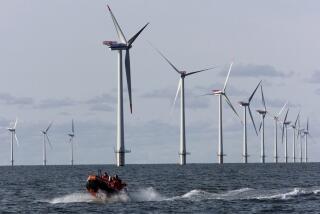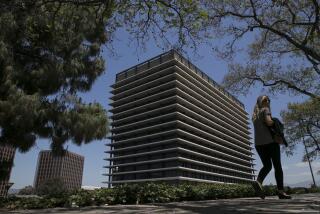Green Businesses Not Just Tilting at Windmills
- Share via
TRAVERSE CITY, Mich. — Dick Dell’Acqua says he believes in doing business the environmentally friendly way, even if it costs a bit more.
So when the utility that supplies electricity to his Traverse City restaurant sought volunteers to pay extra for power generated by a windmill, Dell’Acqua signed up.
His Omelette Shoppe & Bakery became a leading sponsor of the project, described by the American Wind Energy Assn. as the nation’s biggest electricity-producing wind turbine.
It’s also the first to be financed by a voluntary surcharge on ratepayers, says Ed Holt, a utility industry consultant who publishes a newsletter on such “green rates.”
Taking part in the program wasn’t painless for Dell’Acqua; the monthly electric bill for his eatery jumped $300, from roughly $1,600 to $1,900.
“When we got our first bill, I said, ‘Holy smoke,’ ” he said. “But this is cleaner energy . . . and it kind of goes along with the whole idea of trying to be a better steward.”
The 160-foot-high, 600-kilowatt windmill was installed in June in an alfalfa field a few miles west of Traverse City.
Positioned atop a bluff where breezes off Lake Michigan average 14.5 miles per hour, the machine is expected to produce 1.2 million kilowatt hours of electricity a year, enough to supply about 200 homes.
To pay for the project, 145 residential and 20 business customers of city-owned Traverse City Light & Power accepted rate increases of 17% to 23%. For the average residential customer, that’s an extra $7.58 a month.
Along with power, the windmill is generating excitement nationwide among advocates of renewable energy. They say it represents a new concept in environmentalism--the green rate.
It’s based on a simple premise: If you want business and industry to pollute less, you should accept higher prices to help pay the costs of cleaning up their act.
“It really puts the onus on the customers,” said Randy Udall, director of the Community Office for Resource Efficiency, a nonprofit group based in Aspen, Colo., that promotes green pricing in that state.
Environmentalists “have always kind of banged up utilities and businesses,” Udall said. “But here’s a way for us to step up ourselves and make tremendous cuts in air pollution, acid rain, greenhouse gases, all that stuff.”
Green pricing debuted in the United States in 1993, said Holt, who publishes his newsletter on the subject in Harpswell, Maine. The Sacramento Municipal Utility District in California asked ratepayers for an extra $4 per month to have solar panels atop their houses.
About 10 green pricing programs for electricity are in place and two dozen more are in the works, Holt said.
There are several types. Some simply ask customers to contribute regularly to a fund for renewable energy projects.
Another model was introduced this year by Detroit Edison, which began operating a solar-powered generator near Ann Arbor. The utility sells electricity from the generator in 100-watt blocks.
Each block a customer buys adds $6.59 monthly to the base rate, which for residential users is about $50 a month. About 200 have signed up, Detroit Edison spokesman Scott Simons said.
Utilities across the nation are exploring green pricing to finance alternative energy projects, said Chuck Linderman of the Edison Electric Institute, a trade association for investor-owned utilities.
“Whether it will sweep the country, it’s too early to tell,” said Linderman, director of renewable energy programs for Washington, D.C.-based Edison. “But I think it’s going to be more than just a novelty.”
The Traverse City green rate is the nation’s first tied to wind power, Holt said.
It was the brainchild of Steven Smiley, a local consultant who advises businesses on reducing energy costs. Convinced that the area was ideal for wind power, Smiley approached Chuck Fricke, then executive director of Traverse City Light & Power, about putting up a wind turbine.
Fricke, who left his job with Traverse City Light & Power in November, said the utility was pleased so far with the project. If it’s successful after a year, the company may consider a second turbine.
Fricke said the utility didn’t need another power source. Still, he agreed to back the windmill project if it wouldn’t require a rate increase for all 8,000 customers.
Traverse City Light & Power produces and buys electricity from coal and hydro plants for less than 3 cents per kilowatt hour; generating power from the windmill costs around 5.5 cents per kilowatt hour. Smiley’s challenge: Find a means of compensating the utility for the higher cost of producing cleaner energy.
Smiley got a state grant and a federal energy production incentive, which is similar to a tax credit. Building them into the equation, he figured that if roughly 200 residential customers paid an extra 1.58 cents per kilowatt hour, the cost gap between wind and traditional power generation would disappear.
Electricity from the windmill doesn’t go directly to the volunteer ratepayers’ homes and businesses; it simply becomes a part of the utility’s power grid.
Nonetheless, Fricke said, participants can rightfully say their electricity is wind-generated. Each residential green rate customer saves the equivalent of 3 tons of coal and prevents 10,000 pounds of carbon dioxide emissions a year, he said.
Businesses can offset some of the cost by using participation in the program as a marketing tool, Dell’Acqua said. That was one reason he swallowed the higher rate.
“It gives us a little higher profile, shows that we’re doing our bit to be good citizens,” he said.
More to Read
Inside the business of entertainment
The Wide Shot brings you news, analysis and insights on everything from streaming wars to production — and what it all means for the future.
You may occasionally receive promotional content from the Los Angeles Times.










